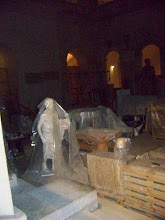When you put two random images together, side by side, they seem to take on a singular form, as if the juxtaposition creates the effect.
 Is that so?
Is that so?
So be it.
This is a phrase I identify with living Zen:
Is that so?
I got this from a koan about a priest who is accused by a young woman of getting her pregnant.
When her parents confront him with what they think he did, he doesn’t deny it or admit it. He says, Is that so?
He loses his reputation, everybody despises him, c alls him a pervert, spits on him, and years later, after living in the streets as a beggar, the girl confesses that it wasn’t the priest, but a boy she was in love with.
The people come to the priest to tell him that they are sorry for treating him so badly. They tell him that they found out the truth.
Is that so? he asks.
The point of this koan --(or one of the points, because there are as many points to a story as there are people to read them)-- is the idea that if one wants to move toward enlightenment, one must receive all things as equal, praise as well as disdain.
This idea of everything being equal can take on many meanings, depending on the perspective. It can mean, for example, to trust God (the universe, life, goodness, or any of the other seventy plus names for the ein sof).
I find “Is that so?” to be similar in many ways to the Judeo Christian tradition of saying “Amen,” which means, So be it.
 Is that so?
Is that so? So be it.
So be it.This is the only organizing principle for these juxtapositions.
 Is that so?
Is that so? So be it.
So be it.I put them together careful not to make a statement or try to express a meaning.
Obviously I will make unconscious cultural and intellectual choices when I juxtapose any two images, but I’m not trying to say anything. Also obvious is that I will make choices based on symmetry, color, lighting, etc.
Perhaps that is more of a factor in how images choose each other.
A few times, when I tried to put an image with another, it resisted, until I found its partner.
But the meaning is in the juxtaposition itself, and the connections a viewer makes will be their creation, their statement on reality.
The meaning is in the thing itself.
 Is that so?
Is that so?
So be it.
##################################################################
Is that so?


So be it.
######################################################################




No comments:
Post a Comment